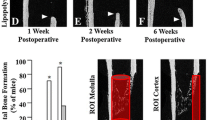Abstract
A model of cortical bone repair has been established for use in mice. The cortical defect consisted of a hole drilled through the entire diameter of the tibial diaphysis. The hematoma that initially filled the drill site was invaded by cells of mesenchymal appearance within 5 days of injury. Trabeculae of mineralized woven bone were present throughout the drill site by day 9. A reaction in the periosteum adjacent to the drill site, consisting of both new bone and cartilage formation, preceded deposition of bone tissue in the drill site. New woven bone was modeled to restore the marrow cavity to normal by 4 weeks after injury, and almost normal cortical structure was achieved by 6 weeks after injury. Immunohistochemical studies indicated that type III collagen was expressed within the drill site by day 5, reached a peak at day 7, and was diminished by day 9. In contrast, type I collagen was first detectable in the drill site at day 7, and staining was more intense by day 9. Osteopontin expression in the drill site coincided with the process of mineralization of new bone in this location. The model of bone repair described here provides a method for inducing reproducible bone lesions in a readily identifiable location in mice. It will be useful in the investigation of bone cell function in mouse strains that have been subjected to genetic manipulation.





Similar content being viewed by others
References
EJ Mackie RP Tucker (1999) ArticleTitleThe tenascin-C knockout revisited. J Cell Sci 112 3847–3853 Occurrence Handle1:CAS:528:DyaK1MXotV2ltrY%3D Occurrence Handle10547346
TP Strandjord DK Madtes DJ Weiss EH Sage (1999) ArticleTitleCollagen accumulation is decreased in SPARC-null mice with bleomycin-induced pulmonary fibrosis. Am J Physiol 277 L628–635 Occurrence Handle1:CAS:528:DyaK1MXmt1alurs%3D Occurrence Handle10484471
H Yoshitake SR Rittling DT Denhardt M Noda (1999) ArticleTitleOsteopontin-deficient mice are resistant to ovariectomy-induced bone resorption. Proc Natl Acad Sci USA 96 8156–8160 Occurrence Handle10.1073/pnas.96.14.8156 Occurrence Handle1:CAS:528:DyaK1MXltVOrsL8%3D Occurrence Handle10393964
WT Bourque M Gross BK Hall (1992) ArticleTitleA reproducible method for producing and quantifying the stages of fracture repair. Lab Anim Sci 42 369–374 Occurrence Handle1:STN:280:ByyD28%2FosFA%3D Occurrence Handle1434497
A Hiltunen E Vuorio HT Aro (1993) ArticleTitleA standardized experimental fracture in the mouse tibia. J Orthop Res 11 305–312 Occurrence Handle1:STN:280:ByyB2cnovFE%3D Occurrence Handle8483044
MF Paccione SM Warren JA Spector JA Greenwald PJ Bouletreau MT Longaker (2001) ArticleTitleA mouse model of mandibular osteotomy healing. J Craniofac Surg 12 444–450 Occurrence Handle1:STN:280:DC%2BD3MrisFCgtQ%3D%3D Occurrence Handle11572249
G Li G White C Connolly D Marsh (2002) ArticleTitleCell proliferation and apoptosis during fracture healing. J Bone Miner Res 17 791–799 Occurrence Handle12009009
EJ Mackie S Ramsey (1996) ArticleTitleExpression of tenascin in joint-associated tissues during development and postnatal growth. J Anat 188 157–165 Occurrence Handle1:CAS:528:DyaK28XisVCgsrw%3D Occurrence Handle8655402
M Page J Hogg DE Ashhurst (1986) ArticleTitleThe effects of mechanical stability on the macromolecules of the connective tissue matrices produced during fracture healing. I. The collagens. Histochem J 18 251–265 Occurrence Handle1:CAS:528:DyaL28XltFeisrc%3D
M Yamazaki F Nakajima A Ogasawara et al. (1999) ArticleTitleSpatial and temporal distribution of CD44 and osteopontin in fracture callus. J Bone Joint Surg Br 81 508–515 Occurrence Handle10.1302/0301-620X.81B3.9398 Occurrence Handle1:STN:280:DC%2BD3czjtFWrsg%3D%3D Occurrence Handle10872376
X Li W Gu G Masinde et al. (2001) ArticleTitleGenetic variation in bone-regenerative capacity among inbred strains of mice. Bone 29 134–140 Occurrence Handle10.1016/S8756-3282(01)00497-5 Occurrence Handle1:STN:280:DC%2BD3Mvls1yjtw%3D%3D Occurrence Handle11502474
H Uusitalo J Rantakokko M Ahonen et al. (2001) ArticleTitleA metaphyseal defect model of the femur for studies of murine bone healing. Bone 28 423–429 Occurrence Handle10.1016/S8756-3282(01)00406-9 Occurrence Handle1:STN:280:DC%2BD3Mzps1Wktw%3D%3D Occurrence Handle11336924
I Eerola H Uusitalo H Aro E Vuorio (1998) ArticleTitleProduction of cartilage collagens during metaphyseal bone healing in the mouse. Matrix Biol 17 317–320 Occurrence Handle10.1016/S0945-053X(98)90084-1 Occurrence Handle1:CAS:528:DyaK1cXlsFCls70%3D Occurrence Handle9749947
Acknowledgements
This work was supported by the National Health and Medical Research Council of Australia, Project Grant No. 114140. The authors thank Su Toulson for excellent technical assistance.
Author information
Authors and Affiliations
Corresponding author
Rights and permissions
About this article
Cite this article
Campbell, T., Wong, W. & Mackie, E. Establishment of a Model of Cortical Bone Repair in Mice . Calcif Tissue Int 73, 49–55 (2003). https://doi.org/10.1007/s00223-002-2120-4
Received:
Accepted:
Published:
Issue Date:
DOI: https://doi.org/10.1007/s00223-002-2120-4




